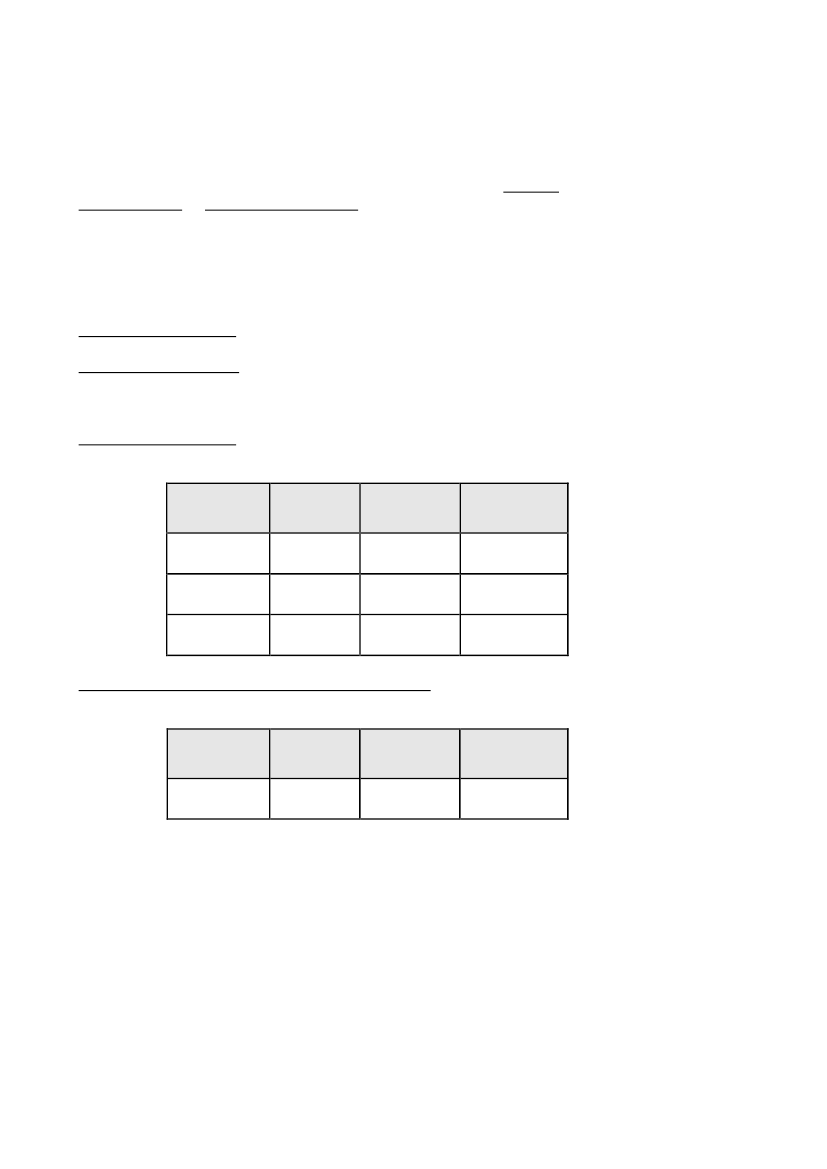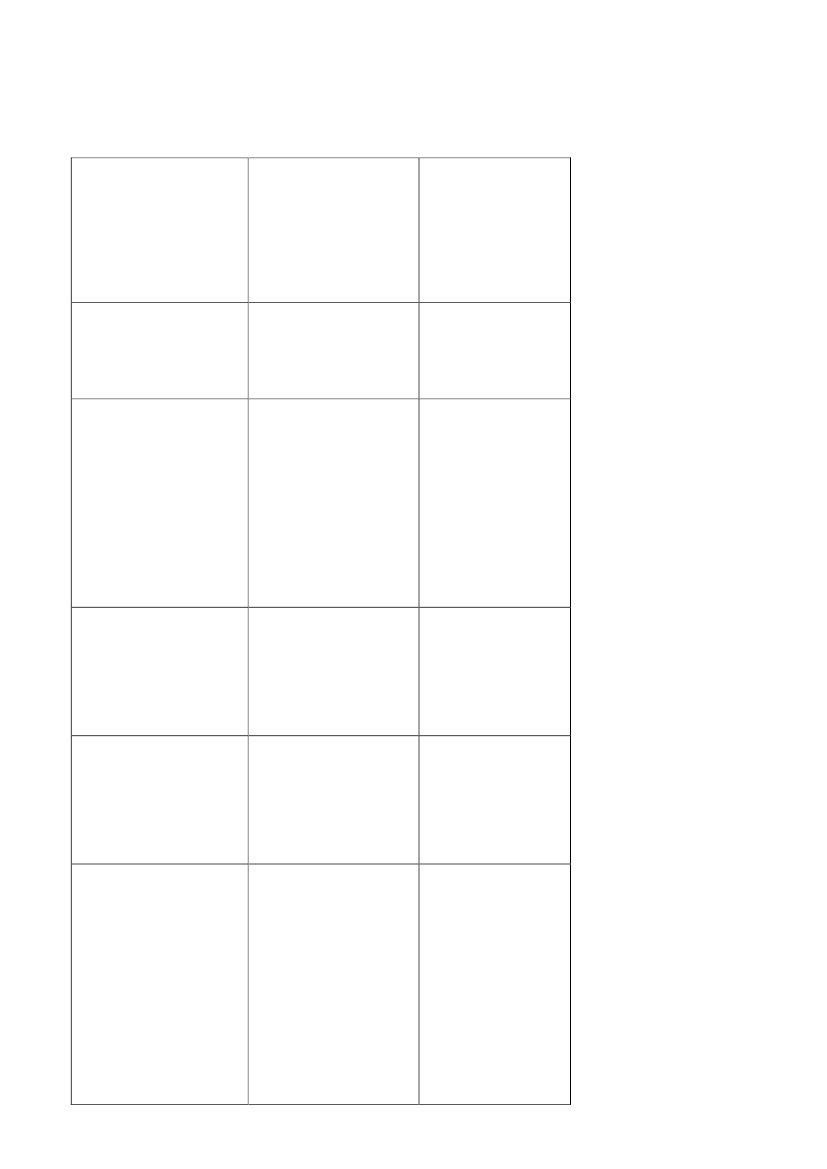Sundheds- og Forebyggelsesudvalget 2012-13
SUU Alm.del Bilag 434
Offentligt
Holbergsgade 6DK-1057 København KT +45 7226 9000F +45 7226 9001M[email protected]Wsum.dk
Folketingets Sundheds- og Forebyggelsesudvalg
Dato: 26. august 2013Enhed: SygehuspolitikSagsbeh.: SUMTKSags nr.: 1301750Dok nr.: 1272391
Som opfølgning på min besvarelse af spørgsmål nr. 561 og 562 stillet den 27.marts 2013, har Sundhedsstyrelsen via de danske ambassader i de respektivelande indhentet oplysninger om lovgivning m.v. vedrørende trådløs telekom-munikation i Storbritannien, Frankrig, Rusland, Italien og Israel. Der er anmo-det om oplysning i forhold til følgende, konkrete forhold:--Relevant lovgivning vedr. trådløs telekommunikationInformation om grænseværdier på området, eksempelvis grænser forudstråling fra mobilmaster, mobiltelefoner etc. Særlig interesse har in-formation om lovbestemte grænseværdier, der afviger fra ICNIRPs (In-ternational Commission on Non-Ionizing Radiation Protection) anbefa-linger med begrundelser for afvigelsen.Information om særlige foranstaltninger rettet mod børn og unge, ek-sempelvis i skoler, børnehaver.Information om særlige anbefalinger vedr. trådløs telekommunikation,der afviger fra ICNIRPs anbefalinger.
--
Sundhedsstyrelsen har på baggrund af de fremsendte oplysninger bemærket”at EU-medlemsstaterne Storbritannien, Italien og Frankrig følger de anbefale-de grænseværdier fastsat af ICNRIP (International Commission on Non-Ionizing Radiation Protection) for eksponering fra radiofrekvent elektromagne-tisk stråling. Italien opererer i tillæg til de fastsatte grænseværdier for ekspone-ring med opmærksomhedsværdier og kvalitative målsætninger. Israel opererermed referenceniveauer for befolkningen på 10 % af ICNIRPs anbefaledegrænseværdier ved kontinuert eksponering for radiofrekvent elektromagnetiskstråling. Rusland har fremsendt en oversigt over tekniske krav til sendeudstyrm.v., ligesom det oplyses, at det ikke har været muligt for Kommunikationsmi-nisteriet at indhente informationer om regulering af trådløs kommunikation.Det fremgår desuden, at ud over Frankrig, der har lovfastsat forbud mod atbruge unge under 14 år til at reklamere for mobilsalg, forbud mod brug af mo-biltelefoner på skoler samt mulighed for at forbyde radioelektrisk udstyr tilegnetbørn under seks år, har de øvrige fire lande ikke lovfastsatte krav om særligeforanstaltninger rettet mod børn og unge i skoler og børnehaver. Som i Dan-mark har samtlige fem lande anbefalinger til børn og unges brug af mobiltele-foner, ligesom det fremgår, at der i varierende grad er anbefalinger rettet modbørn og unges brug af mobiltelefoner og trådløse netværk i skoler og børne-haver.Sundhedsstyrelsen vurderer samlet, at reguleringen og de generelle anbefa-linger rettet mod befolkningens eksponering for radiofrekvent elektromagnetiskstråling, der refereres i de modtagne oplysninger fra de fem lande, i al væsent-
Side 2
lighed er i overensstemmelse med den danske regulering og de danske anbe-falinger på området.”Sundhedsstyrelsen har modtaget følgende besvarelser på de stillede spørgs-mål:Storbritannien:”1. Relevant lovgivning vedr. trådløs telekommunikation.The UK has no specific legislation relating to wireless comms – Health andsafety is the employers’ responsibility also for affected members of the publicunder the health and Safety at Work Act 1974.
2. Information om grænseværdier på området, eksempelvis grænser for ud-stråling fra mobilmaster, mobiltelefoner etc. Særlig interesse har informationom lovbestemte grænseværdier, der afviger fra ICNIRPs (International Com-mission on Non-Ionizing Radiation Protection) anbefalinger med begrundelserfor afvigelsen.The UK adheres to ICNIRP Recommendations as set out in EU Recommenda-tion 519/1999/EU
3. Information om særlige foranstaltninger rettet mod børn og unge, eksempel-vis i skoler, børnehaver.DH advice is that children should apply the precautionary principle and chil-dren should minimise use by texting and using hands free kit. DH also publisha leaflet with advice for children and young people.See at:https://www.gov.uk/government/uploads/system/uploads/attachment_data/file/147418/dh_124899.pdf.pdf4. Information om særlige anbefalinger vedr. trådløs telekommunikation, derafviger fra ICNIRPs anbefalinger.The UK has no special recommendations.”Frankrig:"Den franske lovgivning på det trådløse telekommunikationsområde er baseretpå EU-direktivet 1999/5/CE og efterfølgende overført til national lovgivning veddekret no. 2002-775 af 3. maj 2002�. Frankrig har parallelt tilsluttet sig de in-ternationale retningslinjer, som er fastsat af Den internationale standardise-ringskommission (ICNIRP).På nationalt plan varetager ANSES, nationalt agentur for fødevare- og ar-bejdsmiljøsikkerhed, udformningen af anbefalinger, der danner fundamentetfor de politiske overvejelser og den lovgivningsmæssige proces. Agenturet ud-færdigede en rapport i 2009. Den bliver p.t. ajourført og forventes afleveret tilregeringen til september.
Side 3
Af specielle konkrete tiltag baseret på anbefalingerne fra ANSES og specieltrettet mod børn og unge tager artikel 183 og 184 i lov no. 2010-788 af 12. juli2010� højde for følgende foranstaltninger:Forbud imod at bruge børn under 14 år til at reklamere for mobilsalgeller mobilbrug. I reklamer generelt skal SAR-værdien altid være op-lyst i W/kg (Den specifikke absorptionshastighed)Forbud imod, at en elev bruger sin mobiltelefon i løbet af en undervis-ningstime og ligeledes forbud imod brug på andre steder på skolensareal i overensstemmelse med internt reglementMulighed for at forbyde radioelektronisk udstyr tilegnet børn underseks år
Lov no. 2013-595 af 8. juli 2013� om omdannelse af folkeskolen indeholder iannekset et afsnit om WIFI, hvor man under henvisning til de gængse bekym-ringer om skadelige effekter opfordrer til, at staten og de lokale myndighederbegunstiger bredbåndsforbindelser, når systemet er kompatibelt med pæda-gogisk brug og stedlige forhold.Det er ydermere værd at bemærke, at et lovforslag blev præsenteret den 12.december 2012⁴ af partiet De Grønne. Udspillet var foranlediget af den kom-mende implementering af 4G-netværket i Paris.Partiet stillede spørgsmål ved lovgivningen på området, som vurderedes uklarog utilstrækkelig, samt ved de radiofrekvente elektromagnetiske bølgers sund-hedsmæssige virkning. Lovforslaget blev nedstemt.1.http://www.legifrance.gouv.fr/affichTexte.do?cidTexte=JORFTEXT0000002264012.http://www.legifrance.gouv.fr/affichTexteArticle.do;jsessionid=3BE6978495355AF99FBC3592C2C82F16.tpdjo02v_3?idArticle=JORFARTI000022471504&cidTexte=JORFTEXT000022470434&dateTexte=29990101&categorieLien=id&http://www.legifrance.gouv.fr/affichTexteArticle.do;jsessionid=F59ADCD4D5922CCED3AB7CBB74660AC7.tpdjo03v_3?idArticle=LEGIARTI000022473164&cidTexte=LEGITEXT000022472766&dateTexte=201307153.http://www.legifrance.gouv.fr/affichTexte.do?cidTexte=JORFTEXT0000276779844.http://www.assemblee-nationale.fr/14/propositions/pion0531.asp”Italien:”Relevant lovgivning vedr. trådløs telekommunikation:Lovgivningen vedrørende eksponering for stråling fra trådløs telekommunikati-on blev fastsat i 2001 og ændret i 2003. Den opererer med tre grænseværdierfor stråling fra trådløs telekommunikation, der er fastsat ud fra et forsigtig-hedsprincip.Grænse for eksponering: Dette er den maksimale grænse, hvor ingen under
Side 4
nogen omstændigheder bør udsættes for højere værdier.Udover den maksimale grænse for eksponering opererer Italien med opmærk-somhedsværdier og kvalitative målsætninger.Opmærksomhedsværdien er den stråling, som ikke må overskrides i områder,hvor folk opholder sig i mere end fire timer ad gangen såsom beboelsesområ-der, arbejdspladser og skoler. Denne grænse er identisk med de kvalitativemålsætninger for samtlige nyopførte bygninger.Lovbestemte grænseværdier:Grænsen for eksponering er den samme som ICNIRP’s anbefaling på 60 V/m.Opmærksomhedsværdien, som ikke må overskrides i områder, hvor folk op-holder sig i mere end fire timer ad gangen, er en reduktion på cirka ti gange afden øvre grænse for eksponering og befinder sig på 6 V/m.Grænsen for eksponering beskrives også i denne tabel, som blev tilsendt medsvaret:Elektriskfelt60 V/m20 V/m40 V/mMagnetiskfelt0,2 A/m0,05 A/m0,1 A/m
Frekvens0,1 – 3 MHz3 MHz – 3000MHz3000 MHz –300 GHz
Effekttæthed-1 W/m4 W/m2
2
Opmærksomhedsværdien og de kvalitative målsætninger beskrives i dennetabel:ElektriskfeltMagnetiskfelt0,016 A/m
Frekvens
Effekttæthed0,1 W/m2
0,1 MHz – 3006 V/mGHz
Særlige foranstaltninger rettet mod børn og unge:Der er ingen særlige foranstaltninger rettet mod børn og unge, da de i forvejenganske lave opmærksomhedsværdier menes at være lave nok til også at be-skytte dem.Særlige anbefalinger, der afviger fra ICNIRPs anbefalinger:Det italienske sundhedsministerium anbefaler at begrænse børns brug af mo-biltelefoner. Denne anbefaling findes dog ikke at være i strid med ICNIRPsanbefalinger.”./.Med svaret blev tilsendt en undersøgelse af forskellige europæiske landeslovgivning og grænseværdier for trådløs telekommunikation, som vedlæggestil orientering.
Side 5
Rusland:“Reference data about the Russian law in sphere of wireless telecommu-nication networkIn the Russian Federation in 2003 there was passed a Federal law “On Com-munication” (further – the Law), which establishes the legal fundamentals forthe activities in the sphere of communication on the territory of the RussianFederation and territories which are under the Russian Federation jurisdiction.The regulation of the activities in the sphere of communication, including thethusage of the radio-frequency spectrum, is described in the 5 Chapter of theLaw. The use of the radio-frequency spectrum is regulated by an interagencycollegial body responsible on radio frequencies questions under the federaladministration on Communications (further - the State Commission for RadioFrequencies), which has the full authority in the regulation of the radio-frequency spectrum. The State Commission for Radio Frequencies sets therules and requirements for the engineering specifications of communicationtools used networks of wireless mobile communication (for example, the Reso-thlution dated by the 7of May 2007 № 07-20-03-001“On the detachment ofradio frequency lines for short-range devices” establishes specifications forshort-range devices such as radio microphones, data transferring devices, ra-dio alarm). Generally the State Commission for Radio Frequencies providesthe solutions for each particular band of radio frequencies and the used tech-nology.In the absence of a particular purpose of the request and without any refer-ences for the technologies used, it is not possible to make any complete list ofthe Resolutions made by the State Commission for Radio Frequencies, includ-ing the description of all the technologies and all the radio frequency rangesused. However, we decided to provide you with the specific data on the cellu-lar radio technologies. Could you please find them below.At the same time, the 41 article of the Law states that all the communicationtools should have an assurance, that they comply with the technical regula-tions adopted in accordance with the laws of the Russian Federation on tech-nical regulation, as well as with the requirements of the regulations made bythe federal executive authority in the field of communication on the use ofcommunication tools.In accordance with the article in question, the Ministry of Communications hasapproved a number of orders that set the rules, how to use the base stationsand subscriber terminals of mobile radio communication systems of differentstandards. Table I refers to the documents that establish the requirements forcommunication tools used in modern wireless networks. Is also presents dataon maximum power output power levels established for such equipment.Table 1.Requirements for communication tools used in modern networks of wirelessmobile communicationDocumentReference to the usedMaximum power out-technologyputOrder by the Ministry of“On approval of theup to 24 dBmCommunications andRules, how to use theMass Media of the RFsubscriber terminals ofthdated by the 27 of Au-mobile radiotelephonest
Side 6
gust 2007 No 100
communication systemsof the UMTS standardwith frequency duplexseparation and fre-quency-code division ofradio channels, operat-ing in the range of 2000MHz”“On approval of theRules, how to use thesubscriber terminals ofmobile radiotelephonecommunication systemsof the LTE standard”“On approval of theRules, how to use thesubscriber terminals ofmobile radiotelephonecommunication systemsof the UMTS standardwith frequency duplexseparation and fre-quency-code division ofradio channels, operat-ing in the frequencyrange of 900 MHz”“On approval of theRules, how to use thesubscriber stations (thesubscriber radio stations)of mobile radiotelephonecommunication networkof the IMT-MC-2000standard”“On approval of theRules, how to use thesubscriber stations (thesubscriber radio stations)of mobile radiotelephonecommunication networkof the GSM-900/1800standard”The Orders by the Minis-try of Communicationsand Mass Media of theRF:thdated by the 17 of Feb-ruary 2010 No 31(UMTS);thdated by the 6 of June2011 No 129 (LTE);thdated by the 12 of April2007 No 45(GSM900/1800);thdated by the 7 of No-vember 2007 No 127(IMT-MC-2000);up to 23 dBm
Order by the Ministry ofCommunications andMass Media of the RFthdated by the 6 of June2011 No 128Order by the Ministry ofCommunications andMass Media of the RFthdated by the 13 of Octo-ber 2011 No 257
up to 24 dBm
Order by the Ministry ofCommunications andMass Media of the RFthdated by the 22 of Octo-ber 2008 No 84
Up to 0 DBW (1,0 W)
Order by the Ministry ofCommunications andMass Media of the RFthdated by the 19 of Feb-ruary 2008 No 21
For the second classof power GSM-900 –up to 8 W (39 dBm);for the the third classof power GSM-1800 –up to 4 W (36 dBm)For IMT-MC-450,IMT-MC-2000 – up to33 dBm.For micro base sta-tions GSM 1800 – upto 32 dBm.For UMTS – up to 43dBm;Base station of localcapacity of LTE stan-dard – up to 24 dBm(for one translatingaerial)
The rules, how to usebase stations and retrans-lating units of the mobiletelecommunication net-works
Side 7
dated by the 28 of No-vember 2005 No 134(IMT-MC-450)
th
It should be noticed regarding the recommendations provided by the Interna-tional Commission on Radiological Protection that there is currently no infor-mation on the use of these recommendations by the Ministry of Communica-tions of Russia in sphere of regulating of usage of the wireless communica-tions. In this connection the Ministry of Communications of Russia kindly asksyou to provide us with the recommendations made by the organisation inquestion, which might reasonably be considered under the regulation in thefield of wireless communications, as well as the experience of regulation of thismatter by the Kingdom of Denmark.”Israel:“Following your request, please find below our replies to your queries:In general, the Israeli Health Ministry’s recommendations regarding wirelesscommunication are based on the "precautionary principle”. When developingthese guidelines, the Ministry of Health attempted to consider both the techno-logical needs of Israeli society and the level of caution required on the basis ofcurrent scientific data, so that a balance between the population needs and thepreservation of health could be achieved.A.
Israeli legislation regarding wireless telecommunication
1
1. The non-ionizing radiation law (2006),and the non-ionizing radiationregulations (2009)The non-ionizing radiation law incorporates the precautionary principle andsets the norms for handling and mounting radiation sources and measuringradiation emissions. It defines the measures to be taken in order to reduce therisks generated from the emission of non-ionizing radiation.The law regulates:▪ licensing of installation of non-ionizingradiation sources▪ licensing of operation of non-ionizingradiation sources▪ licensing of radiation measurement servicesEach license/permit will be granted for a specific period of time and in accor-dance with specific conditions. These conditions include assessment of maxi-mum levels of exposure of the public and the environment, and the measuresthat will be taken to limit exposure levels.▪ Certification of appropriately trained public servants as inspectors ofthis law.▪ Conditions for removal of radiation sources or for stopping installation of ra-diation sources.The law mandates keeping detailed records concerning the radiation sourcesor radiation measurement services.Offenders of this law will be subject to criminal penalties.According to this law the public must be informed of the list of the permit hold-ers and of the permits that have been revoked or suspended; location of theradiation sources requiring a permit; assessments of exposure levels; test re-sults of the radiation sources requiring a permit; results of the measurements
1
Please see attached law
Side 8
of the radiation created during the operation of the radiation sources; and re-quests submitted for installation permits.Within the framework of the Non-Ionizing Radiation Law, which came intoforce on January 1, 2007, the Minister for Environmental Protection is empow-ered to promulgate regulations pertaining to the law's implementation. The2009 regulations relate to the validity period of construction and operationpermits; the fees set for the submission of permit requests; requirements forannual radiation measurements and the reporting of their results; and condi-tions for the provision of service permits including tests, professional trainingand availability of equipment as well as publication of the information on thewebsite of the Ministry for Environmental Protection.2. Driving and using a cell phoneRegulation 28b of the traffic regulations issued in 2007stipulates that:"While a vehicle is in motion, the driver should not hold a permanent or mobiletelephone, or use them in the vehicle, unless a hands-free device is used, andtext messages should not be sent or read". According to this regulation, "Ahands-free phone is a device that allows use of the phone without holding it,only if it is installed in the vehicle and placed in a stable position from which itcannot fall.”3. Labeling of cell phones with the SARThe consumer protection regulations issued in 2002 (information regard-ing non-ionizing radiation from mobile telephones),requires that the levelof radiation of the specific telephone, as well as the maximum amount of radia-tion permitted, be marked on the phone.This regulation enables comparison of levels of radiation emitted from differentdevices, providing an additional factor that can be considered when purchas-ing a new cell phone.
B.
Information about special actions directed towards children and youth, for instance, in
schools and kindergartens
As in many other countries, the Israeli Ministry of Health defined infants, chil-dren & adolescents as a sub population which might be more sensitive to ra-diation exposure compared to the adult population.1. Israeli recommendations for cell phone useIn 2008, the Ministry of Health published a set of simple measures aimed toreduce individual exposure from cellular and wireless phones.In brief, the guidelines included recommendations such as using speakers,hands-free devices or earphones when speaking; limiting cell phone use in ar-eas where reception is weak etc.For the young population, the following recommendation was given: “It ishighly recommended that these precautionary measures be implemented es-pecially by children, who generally have been shown to have a greater sus-ceptibility to cancer development following exposure to carcinogens. Since cellphone use among children began later than use among adults, the effects oftheir exposure (to cell phones) has not yet been assessed. In light of their in-creased sensitivity, the long life expectancy of young populations (which al-most certainly includes a significant accumulation of exposure and a long pe-Side 9
riod of time before morbidity development), and ethical issues that are involvedin the decision making process in minors, special precautions for this popula-tion is required.Therefore, the Ministry of Health recommends that par-ents reduce exposure of children to cell phones as much as possible,carefully consider the age at which cell phone use should start, and inany case, ensure the use of (non-wireless) ear-phones or speakers whenusing a cell phone.”2. Exposure of children and adolescents to wireless technologies inschools and kindergartensIn 2010, in accordance with a request of the Israeli Parliament (the Knesset), aposition paper on this issue, was formulated.The position paper (approved in 2011) focused on:1. Use of cell phones in schools2. Wireless computer network systems, i.e., Wi-Fi, WLAN and laptopsused by teachers and students.3. Electric power, i.e. ELF (Extremely Low Frequency) from power lines,transformers, circuit breakers and other sources.In general, it was agreed that theprecautionary principleshould also be ap-plied in the educational institutions.
Cell phones -it was decided that a balance should be reached between thechoice of the pupil and his parents to use a cell phone and any possible healthand social consequences of this use. This balance should be achieved mainlyby adopting educated cell phone use habits.It was agreed that technological solutions that would disrupt cell phone recep-tion in schools should not be used, for any such solution would cause higherexposure to radiation (a situation which is created in conditions of bad recep-tion).Educational program:A program providing age appropriate knowledge, with the goal of enabling theadoption of proper and sensible cell phone use habits was established. Thecontent of the program includes, amongst other topics, understanding of emit-ted radiation; the risks associated with cell phone use; and the precautionaryprinciple.Among the recommendations for educated use, are the following:shorteningthe duration of calls; preference to text messages over calls; use of headsets;proper use while driving; avoiding night use (due to the effects of lack ofsleep). The program was planned in collaboration with the Cancer & RadiationEpidemiology Unit in the Gertner Institute and the Ministry of Education. Theprogram is monitored by surveys before and after the intervention is carriedout, in order to test its effectiveness.The use of WLAN, Wi-Fi and Laptops by Teachers and Students –a Direc-tor General Statement was issued by the Ministry of Education in May 2013,
Side 10
stating:Educational institutes (i.e. schools grade 1 and above – age 6 years andabove) should always prefer the installation of a wire network unless it entailsa safety hazard emerging from its use and installation. In cases in which thereis a technical justification for installing a Wifi network as well as a pedagogicaljustification for using internet at school (in accordance with the appendix – "us-ing an internet network at school – pedagogical justification" and the appendix- "issues preventing installation of wire network at school – technical justifica-tion"), a wireless network may be installed with consideration to the followinglimitations:1. The age group relates to first grade or above (6 years of age andabove). [The use of wireless networks in kindergartens is prohibited]2. In each class, a wire access point will be installed at the teacher'sdesk and the teacher will use the wire network as long as there is noneed to use the wireless network.3. The intensity of emission should be automatically decreased when notin use4. Wifi access points will be turned off automatically when not in use5. The Wifi mode of devices (cell phones, laptops, tablets, etc.) shouldbe turned off inside the school when not in use.6. Each room, corridor or classroom should have at least one router and2there should be at least one Wifi router for every 150 m not separatedby walls.7. The number of Wifi access points will be set by the number of users(not less than 25 users per point).8. Devices that cannot connect to the wire network are not permitted9. In grades 1-3 there is a weekly time limit for using the wireless net-work:Grades 1-2 (6-8 year olds) - up to one hour a day and not more than 3hours per week.Grades 3 (8-9 year old) – up to 2 hours a day and not more than 4days a week.
Information about special recommendations regarding wireless telecommunication, which deviate
from ICNIRP’s recommendations
Reference levels imposed are 10% of ICNIRP levels for continuous exposureof the general public to RF frequency.”Med venlig hilsen
Astrid Krag
/
Tove Kjeldsen










